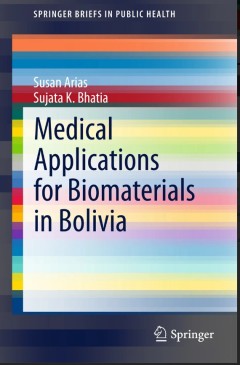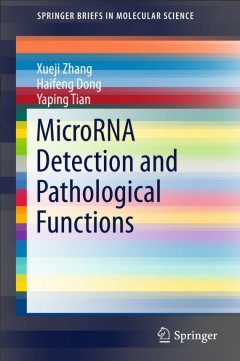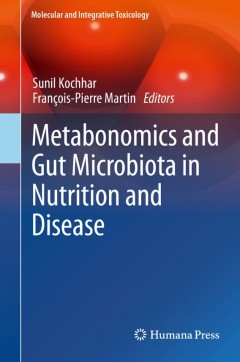Filter by

MicroRNAs and Other Non-Coding RNAs in Inflammation
The book serves as a comprehensive resource for scientists and clinicians studying the role of non-coding RNAs in inflammation (viral infections, wound inflammation), human inflammatory diseases (i.e. rheumatoid arthritis, Crohn’s disease, diabetes) and innate immunity. It provides a universal reference work comprising both basic and specialized information. Given that ncRNAs represent new th…
- Edition
- 1
- ISBN/ISSN
- 978-3-319-13688-2
- Collation
- X, 237
- Series Title
- Progress in Inflammation Research
- Call Number
- -

MicroRNA Detection and Pathological Functions
Dr. Xueji Zhang is a Professor and the Dean at the School of Chemistry & Biological Engineering, University of Science & Technology Beijing (USTB), P.R. China. He received his BSc. and Ph.D. from Wuhan University in 1989 and 1994, respectively. His postdoctoral work was completed at National Institute of Chemistry, Slovenia, Swiss Federal Institute of Technology, Zurich and New Mexico State Uni…
- Edition
- 1
- ISBN/ISSN
- 978-3-662-47292-7
- Collation
- IX, 101
- Series Title
- SpringerBriefs in Molecular Science
- Call Number
- -

Metabonomics and Gut Microbiota in Nutrition and Disease
This book provides a comprehensive overview of metabonomics and gut microbiota research from molecular analysis to population-based global health considerations. The topics include the discussion of the applications in relation to metabonomics and gut microbiota in nutritional research, in health and disease and a review of future therapeutical, nutraceutical and clinical applications. It also …
- Edition
- 1
- ISBN/ISSN
- 978-1-4471-6538-5
- Collation
- XVI, 375
- Series Title
- Molecular and Integrative Toxicology
- Call Number
- -

Metabolic Response of Slowly Absorbed Carbohydrates in Type 2 Diabetes Mellitus
This SpringerBrief focuses on clinical nutrition research, particularly on the effects of slowly absorbed carbohydrates on postprandial glucose metabolism in type 2 diabetes. Slowlyabsorbed carbohydrates will cause gradual increases in blood glucose and insulin levels, and may therefore be effective as part of a treatment strategy for glycemic control and reduction of cardiovascular complicatio…
- Edition
- 1
- ISBN/ISSN
- 978-3-319-27897-1
- Collation
- XVI, 135
- Series Title
- SpringerBriefs in Systems Biology
- Call Number
- -

Metabolic Engineering for Bioprocess Commercialization
This volume reviews the current metabolic engineering tools and technologies from a practical point of view, and guides researchers as they overcome challenges at various stages of organism and bioprocess development. Microbes have been engineered to produce a variety of industrial products such as fuels, basic chemicals, fine chemicals, nutritional supplements, and pharmaceutical intermediates…
- Edition
- 1
- ISBN/ISSN
- 978-3-319-41964-0
- Collation
- V, 122
- Series Title
- -
- Call Number
- -

Sumber Daya Mikroba untuk Energi Berkelanjutan
Buku ini memberikan pencerahan baru tentang bagaimana mikroba dapat digunakan sebagai sumber daya yang efektif dan berkelanjutan untuk menghasilkan energi hijau dalam bentuk biogas, diesel alga, etanol, hidrogen, dan listrik langsung. Ini membahas topik-topik seperti teknologi konversi energi mikroba, termasuk produksi etanol dengan reaksi katalitik mikroba, biometanasi, biodiesel dari mikroalg…
- Edition
- 1
- ISBN/ISSN
- 978-3-319-33776-0
- Collation
- XIX, 280
- Series Title
- -
- Call Number
- -

MicroRNAs and Other Non-Coding RNAs in Inflammation
The book serves as a comprehensive resource for scientists and clinicians studying the role of non-coding RNAs in inflammation (viral infections, wound inflammation), human inflammatory diseases (i.e. rheumatoid arthritis, Crohn’s disease, diabetes) and innate immunity. It provides a universal reference work comprising both basic and specialized information. Given that ncRNAs represent new th…
- Edition
- 1
- ISBN/ISSN
- 978-3-319-13688-2
- Collation
- X, 237
- Series Title
- Progress in Inflammation Research
- Call Number
- -

Metabonomics and Gut Microbiota in Nutrition and Disease
This book provides a comprehensive overview of metabonomics and gut microbiota research from molecular analysis to population-based global health considerations. The topics include the discussion of the applications in relation to metabonomics and gut microbiota in nutritional research, in health and disease and a review of future therapeutical, nutraceutical and clinical applications. It also …
- Edition
- 1
- ISBN/ISSN
- 978-1-4471-6538-5
- Collation
- XVI, 375
- Series Title
- Molecular and Integrative Toxicology
- Call Number
- -

Metabolic Response of Slowly Absorbed Carbohydrates in Type 2 Diabetes Mellitus
This SpringerBrief focuses on clinical nutrition research, particularly on the effects of slowly absorbed carbohydrates on postprandial glucose metabolism in type 2 diabetes. Slowlyabsorbed carbohydrates will cause gradual increases in blood glucose and insulin levels, and may therefore be effective as part of a treatment strategy for glycemic control and reduction of cardiovascular complicatio…
- Edition
- -
- ISBN/ISSN
- 978-3-319-27897-1
- Collation
- XVI, 135
- Series Title
- SpringerBriefs in Systems Biology
- Call Number
- -

Metabolic Engineering for Bioprocess Commercialization
This volume reviews the current metabolic engineering tools and technologies from a practical point of view, and guides researchers as they overcome challenges at various stages of organism and bioprocess development. Microbes have been engineered to produce a variety of industrial products such as fuels, basic chemicals, fine chemicals, nutritional supplements, and pharmaceutical intermediates…
- Edition
- 1
- ISBN/ISSN
- 978-3-319-41964-0
- Collation
- V, 122
- Series Title
- -
- Call Number
- -
 Computer Science, Information & General Works
Computer Science, Information & General Works  Philosophy & Psychology
Philosophy & Psychology  Religion
Religion  Social Sciences
Social Sciences  Language
Language  Pure Science
Pure Science  Applied Sciences
Applied Sciences  Art & Recreation
Art & Recreation  Literature
Literature  History & Geography
History & Geography